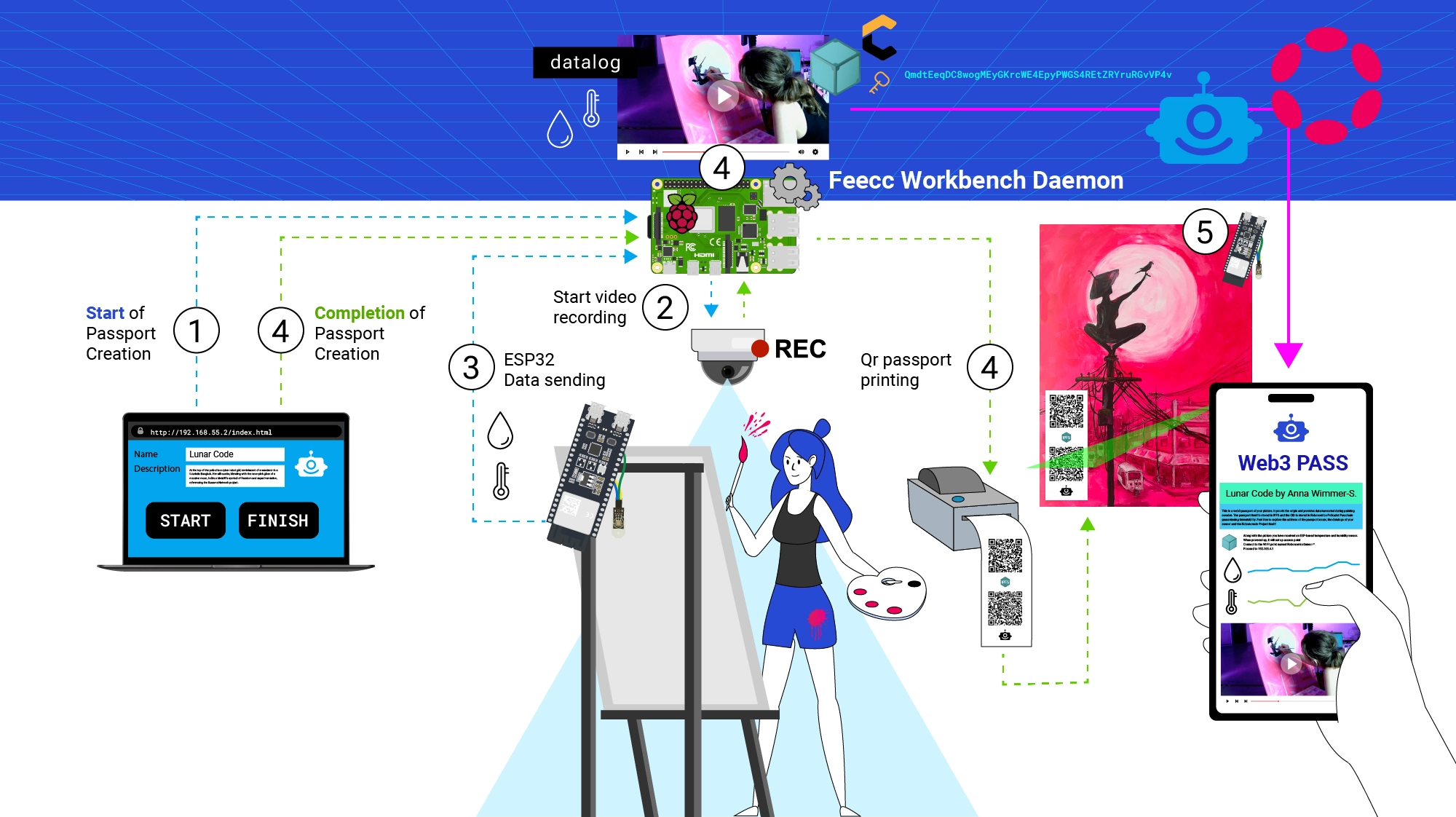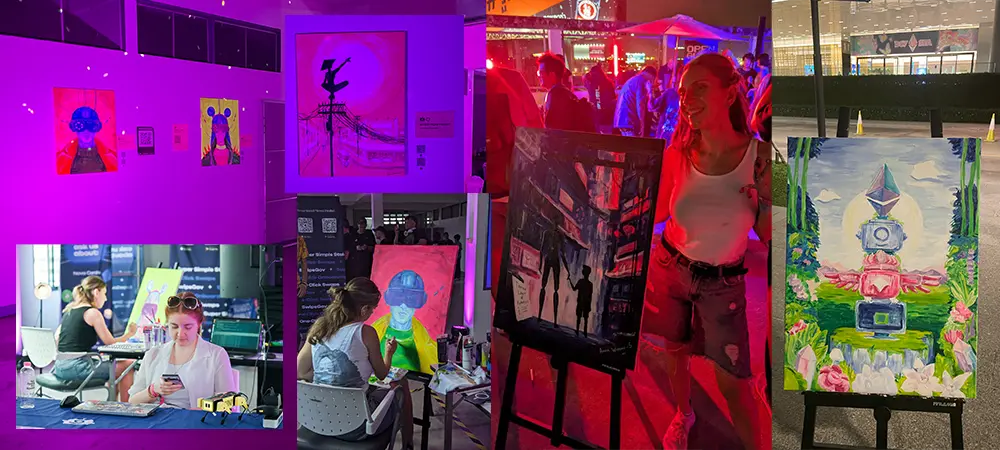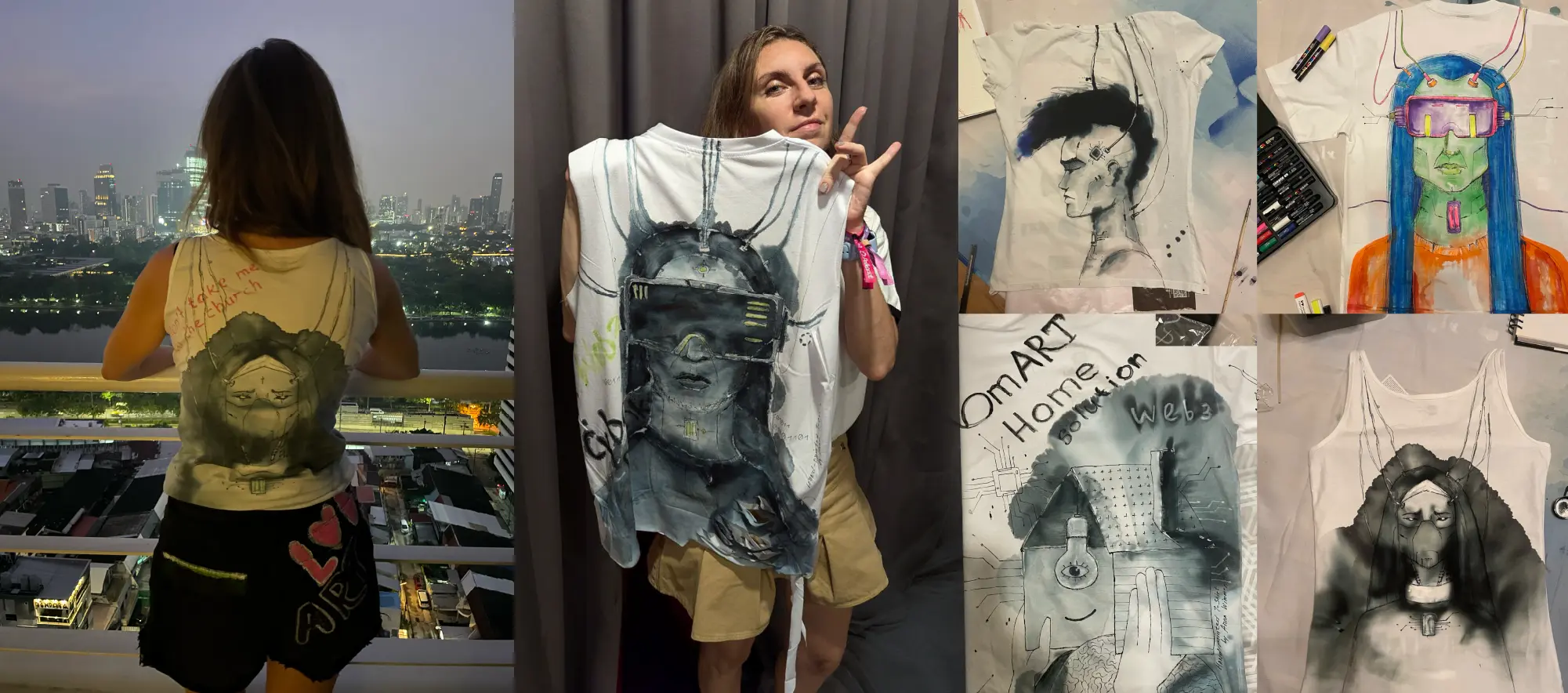ART, Cyberpunk & WEB3: A Return to Canvas Art in the World of Technology
Hello! You know me as a designer for Robonomics, but this year I’ve returned as an artist. I’ve long been observing how rapidly artificial intelligence is developing and how many are using it to create images. AI truly excels at this at a high level. But I had a question: is there still room for real artists in the world of technology? To find the answer, I decided to conduct an experiment.
Anna Wimmer-SavinovaPainting, Cyberpunk, and Web3: How It Works
My experiment took place this November in Bangkok during two major events — Polkadot Sub0 Reset and Devcon.
The theme of the paintings was the cyberpunk of our time, a relevant direction for our team today. In my work, I drew inspiration from William Gibson’s novel “Neuromancer”, the Three Laws of Robotics by Isaac Asimov, and imagined how cyberpunk might look in the modern world and future. My vision was further shaped by the panoramas of Bangkok — a city that itself feels like a city of the future, perfectly capturing the cyberpunk atmosphere.
The painting creation process was recorded on video in real-time. These recordings were uploaded to IPFS with the CID stored on the Robonomics parachain through our Feecc project, creating a digital passport for each painting. This approach ensured complete transparency: anyone could see every stage of the painting process — from the first brushstroke to the final touches. You can learn more about the Feecc project and its features in this article.
We also added temperature and humidity sensors to the paintings, which recorded data on the conditions during their creation. This data was stored in the digital passport and continued to update even after the painting was completed. New owners could activate the sensor, allowing it to keep sending data to the Robonomics parachain, making the artwork part of their digital ecosystem.

Description of the Feecc Process in the Art Experiment
-
Process Start:
When the “Start” button is pressed, the device’s temporary memory is cleared, and the system begins recording new data. At this point, the painting’s title and description are saved, and data collection from connected sensors, such as temperature and humidity, begins. -
Timelapse Recording:
Simultaneously with data recording, a timelapse recording with a factor of 60 is started, capturing the painting creation process. -
Data Transmission:
Throughout the painting process, the sensors transmit data directly to the Robonomics parachain and the Feecc platform. This marked the first public transaction sent to the Robonomics parachain (and possibly across the entire Dotsama ecosystem) using an ESP32 microcontroller. The camera continues recording the timelapse during this phase. -
Completion:
When the “Finish” button is pressed, the system finalizes the recording:- The generated timelapse and data graphs are uploaded to the IPFS network and pinned via Crust for long-term storage and accessibility.
- All identifiers, including the painting’s title and description, are recorded in a digital passport template, which is also uploaded to IPFS with the CID stored on the Robonomics parachain.
- QR codes linking to the transaction and the digital passport on IPFS are automatically printed and attached to the painting, allowing anyone to access the data.
-
Long-term Sensor Operation:
After the painting process is completed, the sensors can continue transmitting data to the network, providing ongoing information about the painting’s storage conditions.
This process demonstrates how IoT and blockchain technologies can integrate into art, creating a transparent and long-term system for documenting creative work.

Digital Painting Passports with IPFS Hashes:
- Painting - Lunar Code
- Painting - Trust in the Digital Age
- Painting - Cyber Pulse
- Painting - Cyber Illusion
- Painting - Evolution of Freedom: The Path of Ethereum
Mobile Artist Studio with Smart Lighting
For this experiment, the Robonomics engineering team helped me create a mobile artist studio equipped with smart lighting automation as part of our Web3 Smart Home project. This setup became a true support system.
I no longer had to constantly get up to adjust the lighting or move lamps based on the time of day. The smart lighting automatically adapted, creating ideal working conditions. This allowed me to stay focused on the creative process without interruptions.
For an artist, this is especially important: lighting directly affects the perception of colors, details, and the overall atmosphere of a painting. With this support, my process became more comfortable and productive.
What I Discovered: Art and Technology Together
The experiment was a success. People’s reactions showed they enjoyed observing the painting process and witnessing a live artist at work. This is an important signal: despite the advancement of AI, genuine art and creativity remain valuable.
I believe art and technology can coexist harmoniously, enriching and complementing each other. My experiment demonstrated that digital solutions can expand the boundaries of creativity rather than replace it.
This approach could also be valuable for art galleries and collectors who carefully preserve their paintings and want transparent data on storage conditions. Temperature and humidity sensors allow for continuous monitoring of artwork during transportation, gallery exhibition, or in a new owner’s home. This method helps ensure maximum preservation and a long life for the artwork.
New Experiment: Cyberpunk-Style T-Shirts
While in Bangkok, I was inspired by the city and its atmosphere to embark on a new experiment — painting on t-shirts. I created several prototype t-shirts in cyberpunk style and plan to launch a full collection in 2025. Each t-shirt, like the paintings, will be equipped with a digital passport uploaded to the Polkadot parachain through the Feecc project.
Digital Passport of the First Cyberpunk T-Shirt with IPFS Hash

Future Plans
This experience has inspired me to keep moving forward. I plan to continue developing this project, exploring new possibilities for the interaction between traditional art and modern technologies. There are many exciting experiments and ideas ahead, and I can’t wait to see what comes next.
Stay tuned for updates, new paintings, and preparations for the launch of the new merch collection on my Twitter: @Anna_Wimmer_S.
